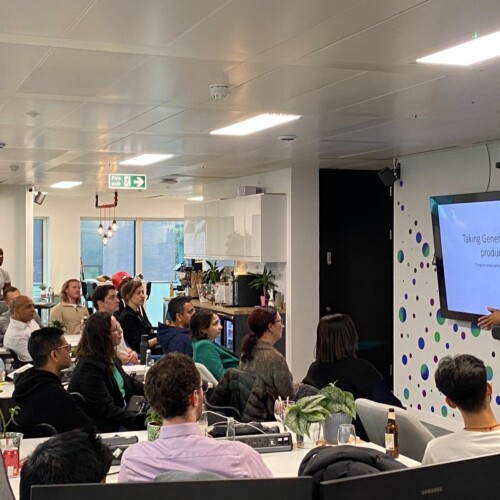Cloud & Platforms
A transparent, repeatable model from forensic analysis, to the development of a prescriptive approach to delivery with a clear focus on capability building and handover.
Stary your journey today
Companies have consistently faced several challenges with computing technology over time. These include running and supporting legacy hardware and applications, providing on-site support for critical infrastructure, swiftly responding to new operational requirements, and maintaining business continuity during a crisis.
The advent of cloud computing introduced benefits and solutions for these and other issues. Exponential data and application migration to hyperscale providers like AWS and Azure has driven further innovation on those platforms.
Simply put, cloud migration frees businesses from traditional IT obstacles.
Find out more on how we can help you build your product, platform, or service
The cloud “gold rush” began in the 2010s, as companies started migrating workloads onto public cloud platforms like those provided by Amazon (AWS), Microsoft (Azure) and Google (GCP). There are four main strategies:
Each has benefits, with investment costs rising at each step along with corresponding rewards.
Companies must devise an effective cloud migration strategy backed by primary business objectives to maximise these benefits. Picking up an application and running it as is on the cloud is rarely the best strategy. Cloud-native and microservice solutions can drive improved reliability, superior customer experience whilst simultaneously reducing infrastructure and support costs – such as the global payment processor deployed in AWS. Look at cloud adoption as an opportunity to set in motion new development methodologies and inspire innovative ways of working.
Cloud migration involves businesses moving their data and information to the cloud. The remote storage infrastructure will also handle business applications and other elements. A managed cloud migration is exceptionally useful for companies that operate internationally. Thus, making it easier to access information.
The investors welcome innovation and modernity, which simplifies operations. Lastly, cloud migration promotes a healthy IT environment that is less costly but boosts performance. It is secure too.
A cloud migration strategy is expert-level planning to transfer a company’s applications and workloads into the cloud. Most of these plans involve a public migration cloud such as Google Cloud Platform, Microsoft Azure, or Amazon Web Services.
Cloud migration strategy involves identifying the workload necessary for the migration. The strategy is launched and tested to ensure efficient results. Companies usually hire cloud migration strategy consulting companies for a step-by-step guide. These professionals will also revise and update the strategy according to business parameters. A managed cloud migration strategy will overcome issues such as unmatched architecture and the use of other tools to make the transition seamless.
Migration in cloud computing is a digital process that happens online in a “cloud”. However, it is also a physical move, in some aspects. On-premise to cloud migration consulting services will guide the clients in uploading data, electronic processes, and applications to remote data centres. In other words, the company does not physically pack and move physical goods.
Cloud computing requires extensive preparation and advanced minds, similar to migrating from a small to a big office. However, the investment is worth the effort as companies witness large savings and enhanced data storing flexibility. In addition, migration also means transferring data from one cloud to a different cloud.
Managed cloud migration has four phases:
The best cloud migration services UK insist on cloud migration testing. Instead of on-premise to cloud migration consulting services, testing involves outsourcing operations to a third party. As a result, the client assesses the data performance in the target applications. Testing analyses the security and availability of the resources.
Moreover, infrastructure downtime is also identified to minimise communication lag. Testing will also provide suggestions to overcome corporate challenges such as geographical barriers, lack of team collaboration, restricted budgets, or lax quality assurance protocols. Cloud migration testing is necessary to gain insight to avoid sunk costs and challenges in the future.
Cloud migration involves transferring data and infrastructure to the cloud. As a result, companies save money and time. However, its biggest drawback is the inability to grow and stay updated with technology. It lacks long-term planning, so companies reach new levels of economic domination.
Cloud modernisation, conversely, is a dynamic process that is advantageous for small and large clients. The strategy involves all business units to actualise their aims. Cloud modernisation builds anticipation and motivates the core staff to adopt the technology. It promotes collaboration, teamwork, and communication. Moreover, cloud modernisation also offers real-time reporting so that companies can extract relevant information for faster results.
A cloud migration strategy has the following elements to ensure a seamless transition.
AWS or Amazon Web Services promises to be more than cloud migration support. The service offers an uncontested user experience and modern solutions for data management. Furthermore, it guarantees assistance every step of the way to guide the employees expertly.
AWS’s cloud migration strategy is popular among millions of worldwide customers with prominent clients such as NASA, Moderna, NHL, Redfin, and Snapchat. AWS cloud migration promotes flexibility and cost-effectiveness. The cloud migration platform has the operational, technological, and corporate features to establish a successful transition. It’s features and modern services offer help to numerous industries. AWS cloud migration will instantly add value to the operations while educating the client extensively.
Microsoft Cloud Adoption Framework has the necessary features and tools to guide clients without complicated steps. The service successfully implements cloud technology and guides individuals, employees, and corporations to use Azure.
Microsoft Cloud Adoption Framework to Azure encircles strategy building. The transition also studies the possible outcomes and the return on investment. Furthermore, the client will map and evaluate other applications. The user selects the Database Migration Service feature from Azure and subscribes to their Migrate Database Assessment for a successful migration. After the steps are complete, Azure cloud migration support manages and supervises the data/information.
A transparent, repeatable model from forensic analysis, to the development of a prescriptive approach to delivery with a clear focus on capability building and handover.
Innovate with confidence by taking control of your data and technology.
Propel your organization's competitive ability to anticipate change, accelerate digital business and drive innovation in times of disruption.

esynergy proudly hosted another London AI meetup on April 25th, drawing over 60 AI practitioners from across the city. Attendees ... Learn more

Is it really necessary to measure the productivity of developers? “Developer productivity” is an emotive, and occasionally misunderstood term. It ... Learn more

FIMA Connect has always been a cornerstone event for finance professionals looking to integrate cutting-edge technology and strategies. During this ... Learn more